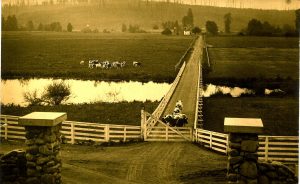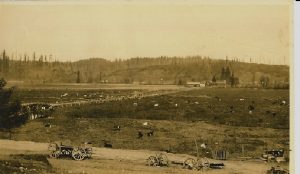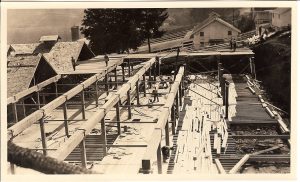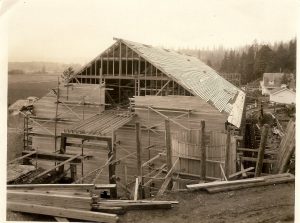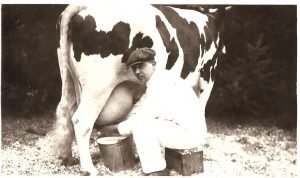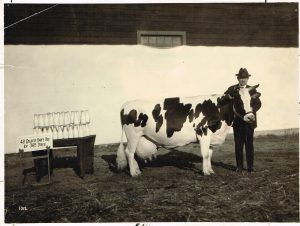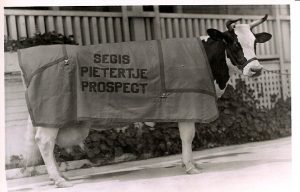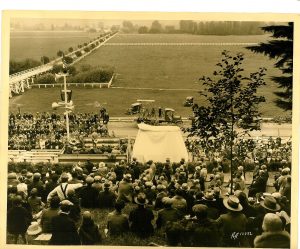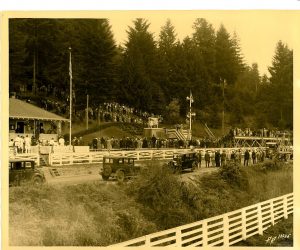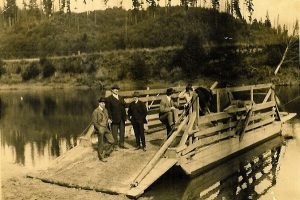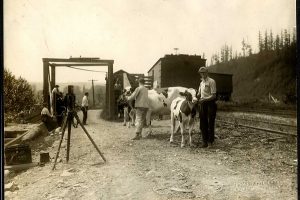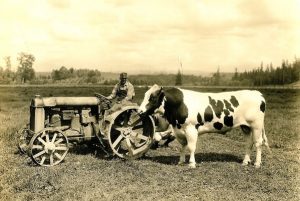Divco Movie Star
By Elbridge H. Stuart III, Carnation Farms Historian
Carnation Milk was so engrained in American culture, it was a kitchen staple in a majority of American households in the 50s, 60s and 70s. So it’s only natural that Quentin Tarentino used Carnation Milk as a visual timestamp in his new movie, Once Upon a Time in Hollywood, set in 1969.

Not only does Brad Pitt’s character, Cliff Booth, drink milk out of a Carnation carton, the Carnation Milk truck rolls down the street in the neighborhood. That truck is a Divco and it has a story of its own, perhaps connected to Carnation Farms. Divco trucks served as the delivery fleets for milk producers across the country, including Carnation Milk Company.
This particular truck was built in 1971 and was based in Southern California near Indio. It was probably sold in 1985 when Carnation Milk quit the home-delivery business and was purchased by a food delivery business that served the military bases around Indio, CA. After that, a collector purchased the truck, and began the restoration process, peeling the layers back to the original Carnation Milk paint scheme.
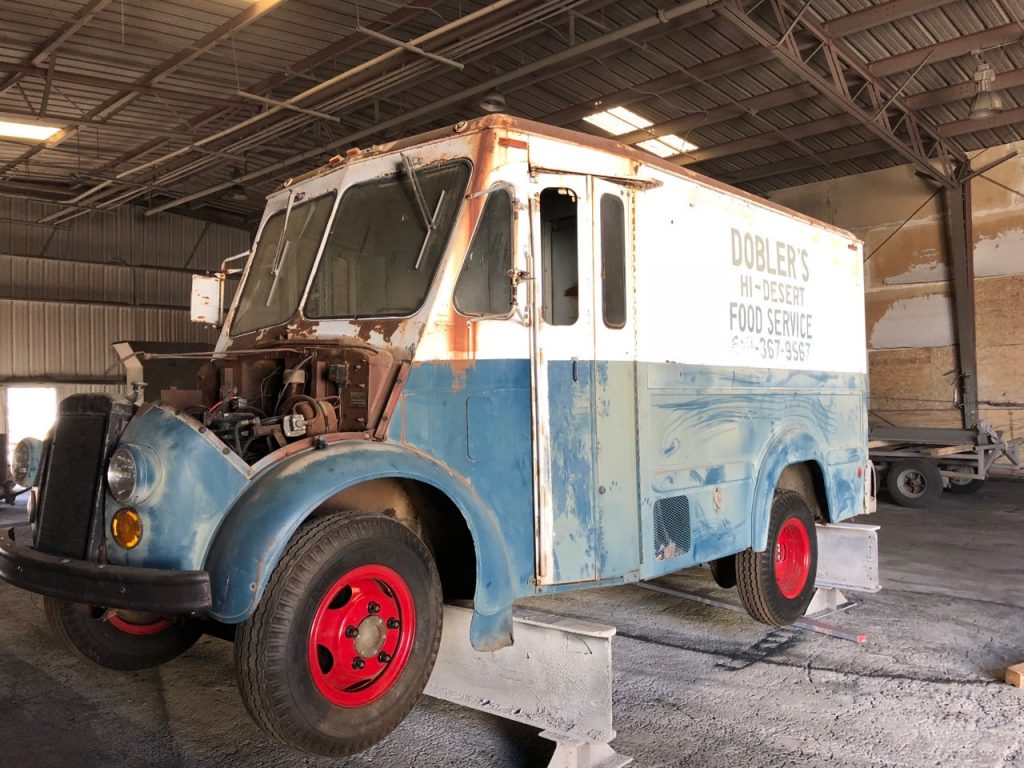
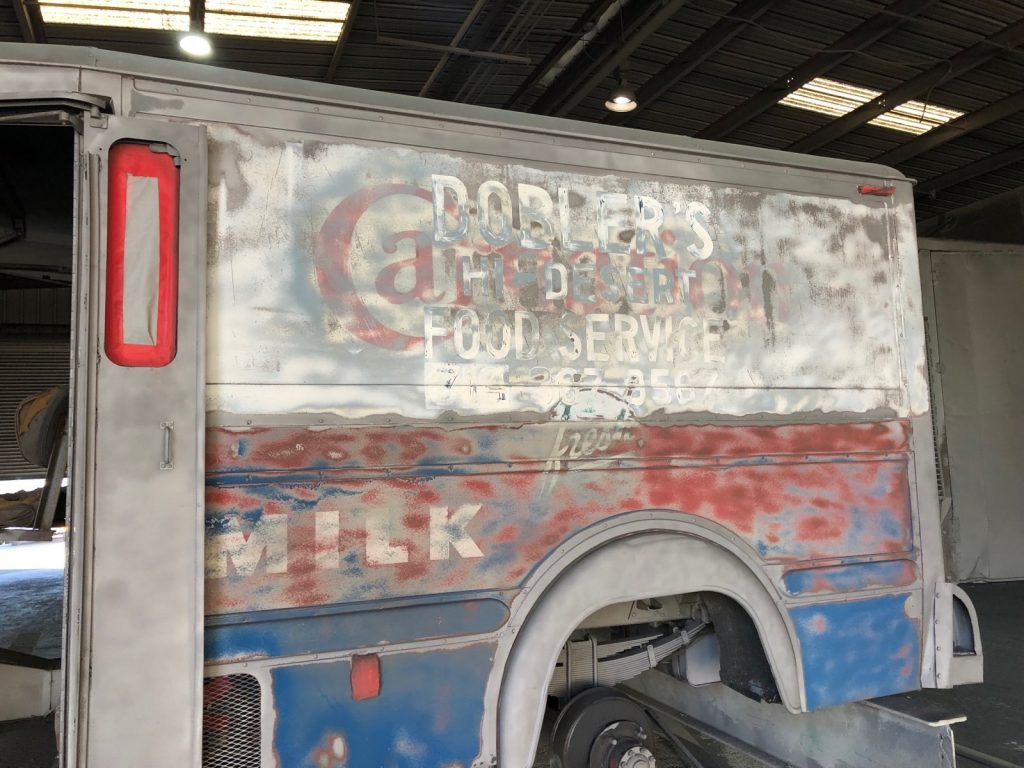
Happily our historian happened to be looking for a Divco to add to the vehicle museum at Carnation Farms and saw the ad for this vehicle. The truck was moved up to Carnation last year. Was this the same Southern California-based Divco that appeared in Once Upon a Time in Hollywood? Did the Carnation Farms Divco enjoy its 15 minutes of fame as a movie star?
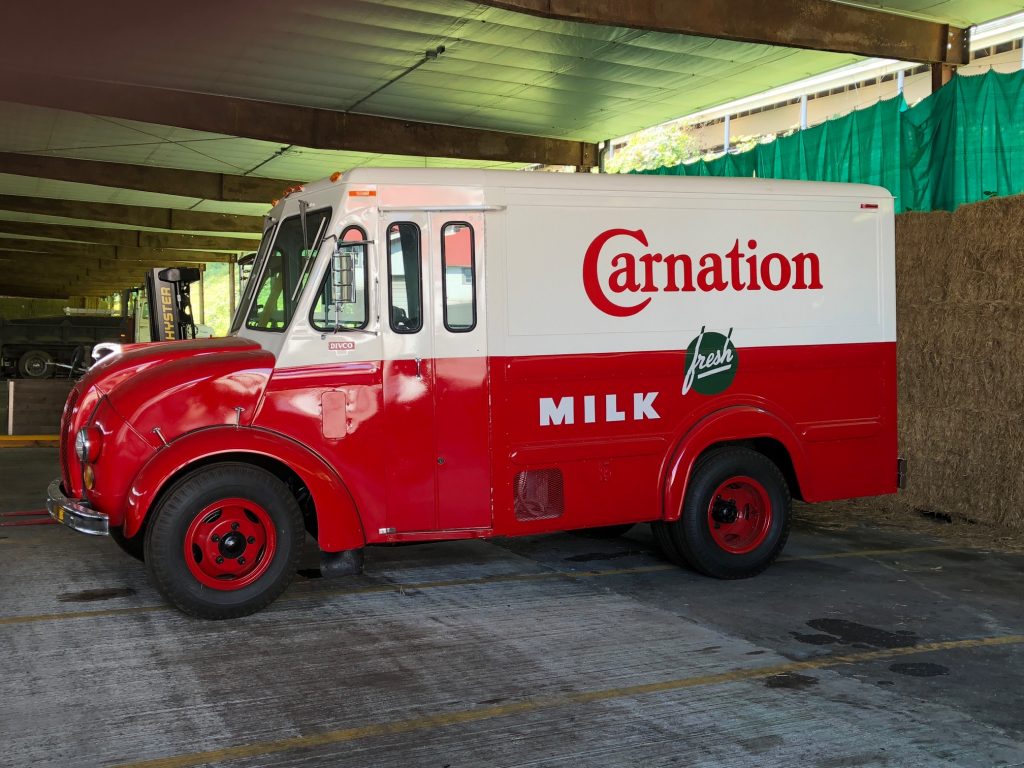
We can’t know for sure, but the speculation makes a good story. And a fun reason to see Once Upon a Time in Hollywood.
Carnation International – the German Subsidiary
By Elbridge H. Stuart III, Carnation Farms Historian
A few years ago, the Paris fashion icon, Karl Lagerfeld, passed away at 85. While Karl was renowned through the fashion world, our interest here at Carnation Farms focuses on his father. Karl’s death and the following retrospectives have surfaced little known details of his fathers’ life.

Karl Otto Lagerfeld
September 1933 – February 2019

September 1881 – July 1967
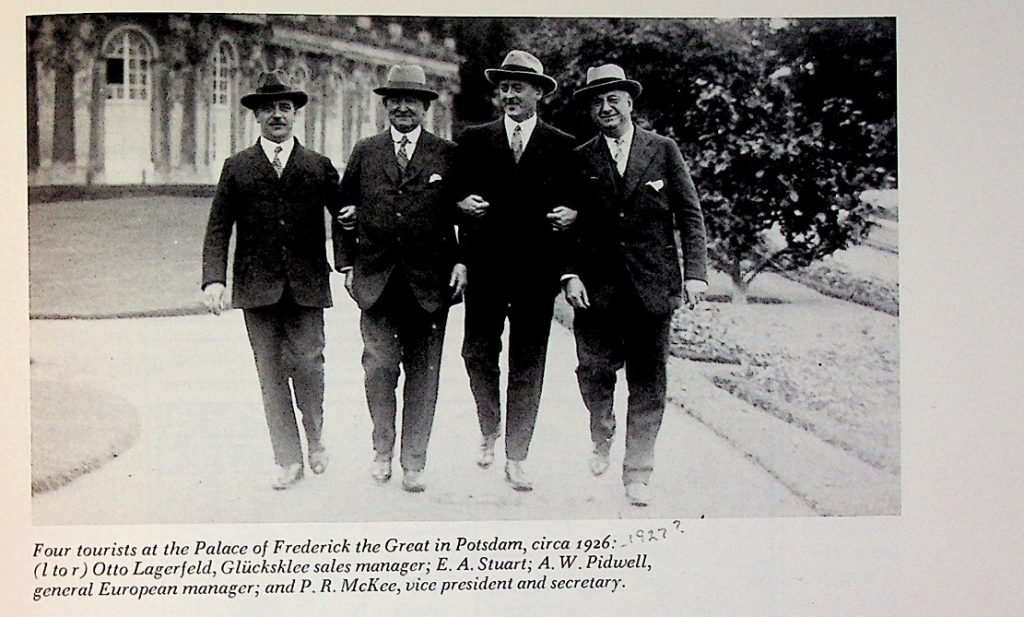
I knew that there was a relationship between Karl Lagerfeld’s father, Otto Christian Ludwig Lagerfeldt and the international division of Carnation Milk. More details of the Otto Lagerfeldt’s life can now be revealed after the death of his son. Much of the timeline of the life and commercial ventures of Otto Lagerfeldt is wrapped in confusion. Information we have is pieced together from records in Vladivostok dating from the Tsarist era that was released the same week that Karl Langerfeld died. The one thing that the stories agree on was that Otto Lagerfeldt brought Carnation Evaporated Milk to Germany and Russia.
This international story began in 1906 when Elbridge Amos Stuart met Otto in San Francisco after the famous earthquake. Otto had recently moved to join a brother in the U.S. and worked for a food company with business contacts in the Far East. Previous work included an apprenticeship in a coffee trading company in Hamburg (his birthplace), German military service, and a stint in Venezuela. During this period, Otto became particularly interested in the benefits of evaporated milk.
In early December 1907, Otto arrived in Russia’s Pacific capital, Vladivostok from San Francisco via Japan. Otto lived and worked in Vladivostok for 7 years.
In Vladivostok, Otto, fluent in spoken and written Russian, was also part of a thriving ex-pat community which socialized in English. He owned a trading company and imported the first evaporated milk directly from Seattle where Elbridge Amos Stuart was the General Manager of the then Pacific Coast Condensed Milk Company. Otto was a successful salesman of evaporated or condensed canned milk under the brand name of Gwosdika or Gvozdika (Clover) trademark.
His son Karl never spoke about his father’s business ventures in Russia. While Karl Lagerfeld sometimes spoke of his father, Otto, as Swedish, evidence indicates that he was German. Now we know Otto paid a heavy price for his German heritage during the First World War.
Otto’s world changed dramatically on August 1, 1914, the day Germany declared war on Russia. Russia’s empress Alexandra may have been German but the hunt was on everywhere for spies. In August of 1914, Otto was detained by the secret police of the last Tsar, Nicholas II as a suspected spy, and handed to the superintendent of Vladivostok fortress to be kept at a guardhouse on Larionov Cape, Russky island. From there he was transferred to Vladivostok regional jail on Nikolayevsky Prospekt, as an individual suspected of ‘espionage’.
He spent four years in the Siberian gulags. By the time of his release or escape, Russia was engulfed by civil war – and indeed although the Bolsheviks had taken power in November 1917, their writ did not run to Verkhoyansk. Exactly how Otto returned to Germany and set up a business by 1919 is not known.
Papers kept at the Russian state historical archive of the Far East show that Otto Lagerfeldt used the family name before he changed the spelling. In Russia he styled himself Otto Ottovich Lagerfeldt. Otto’s son Karl later changed his name again, dropping the “T” from the end of his name.
In 1921 Otto founded his company in Hamburg and began importing Carnation Evaporated Milk for the German market. It was of excellent quality and built a strong customer following. In 1926, heavy duties were imposed on imported evaporated milk. To adapt to these new tariffs, Carnation was prepared and willing to build their first evaporated milk plant in Germany at Nousiadt/Holstein where the famous Holstein cows originated. Holsteins were the only breed of cows that Carnation used for milk production. Evaporated milk production in Germany started in May of 1926 at this new plant.

Looking to adopt a German-sounding name, Otto Lagergeld used the German equivalent of the Russian product name he used in the 1900’s. He named the German product, Glucksklee Milch or “Lucky Clover” Milk. At what point Glucksklee became part of Carnation is unknown. I have seen dates spanning from 1909 to the 1920’s. The original can design was white with the trademark four-leaf clover in the middle. Eventually, the white can gave way to the Carnation red and white can. What is interesting is that the red and white were inverted for the German product and for French product, named Lait Gloria. It is thought that perhaps someone had the copyright for red on top and white on the bottom for another product. The actual reason has been lost to history.


Evaporated Milk and the Beginning of Carnation Farms
September 6, 2018
Before founding the Carnation Milk Company, Elbridge A. (E.A.) Stuart had tried a number of things. He grew up in Indiana and had moved away to pursue various business ventures in Texas and California. Just before coming to Washington he had been involved in a wholesale grocery. He had been brought in to help turn it around and re-energize it and although he had been successful, he was only a minority stockholder and was pushed out by the majority business partners. He was disgusted with how things were handled, but accepted a settlement, insisting he be paid in gold.
Stuart decided to head north to look for a new opportunity. His friend, T.E. Yerxa, pitched him an idea, a new business venture. Yerxa knew of a man that had the patent for evaporated milk and a bankrupt facility that could be used to produce it. Stuart had no experience with evaporated milk but knew a good idea when he saw it.

Evaporated milk was cutting-edge technology at the time and the patent was extremely valuable. Most households did not have refrigeration, so a process that would preserve fresh milk was ground-breaking. Evaporated milk differs from condensed milk in the way it is preserved. Condensed milk uses large quantities of sugar, whereas evaporated milk is made by using a vacuum process with heat sterilization, and the only ingredient is fresh milk. For families, evaporated milk was a much better staple than condensed milk.
The process for evaporated milk was invented and patented by a Swiss immigrant named John Meyenberg. The method involved using a vacuum to remove two-thirds of the water content from fresh milk, turning each quart of milk into one can of evaporated milk.
Stuart and Yerxa used the proceeds from Stuart’s wholesale grocery settlement to purchase a bankrupt condensed milk plant in Kent, Washington. They joined forces with Meyenberg and on September 6, 1899 opened the Pacific Coast Condensed Milk Company. On opening day, the condensery converted 2744 quarts of fresh milk into 55 cases of evaporated milk.
Early on, evaporated milk proved to be a marketing challenge. There were already other companies selling a similar product, but Stuart was determined to produce the finest evaporated milk. Through many trials in perfecting the process, he was able to produce the best and safest product on the market. To stand out from the crowd he developed the catchy Carnation name and distinctive red and white label.
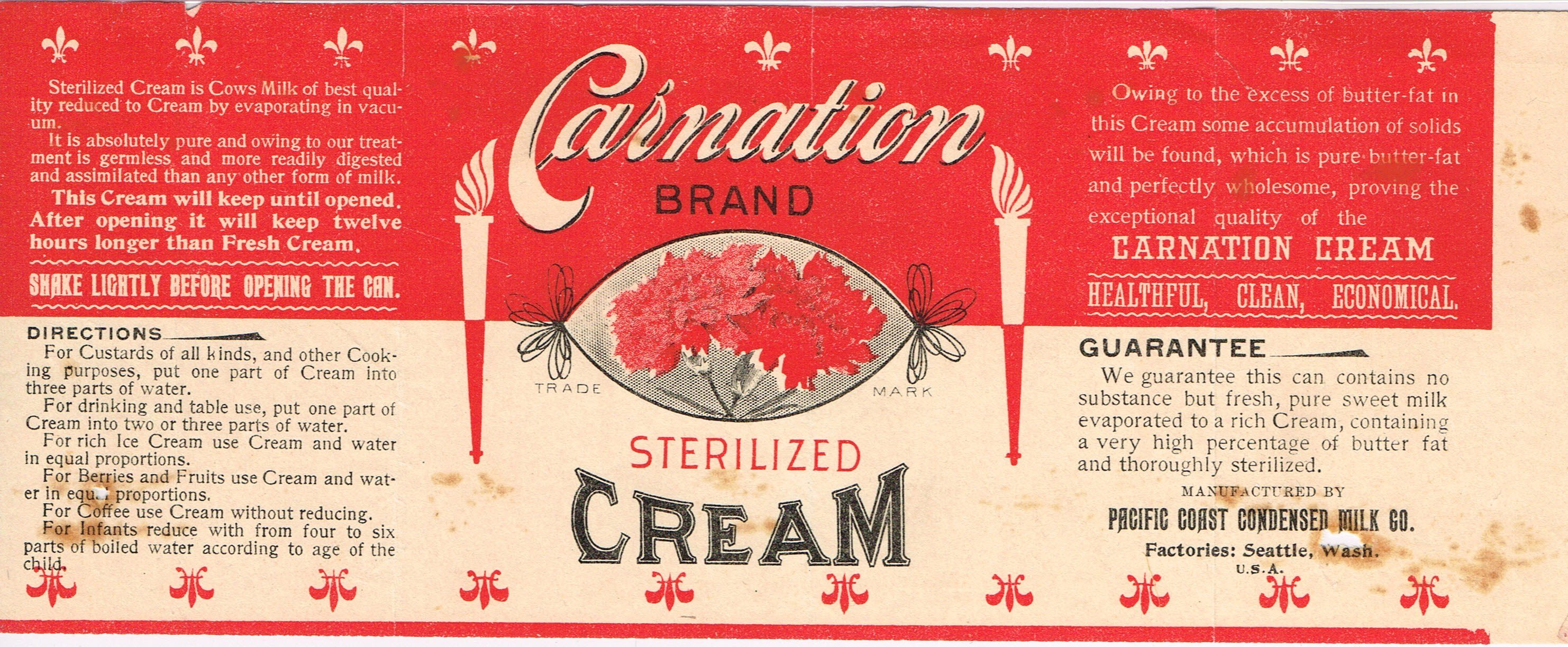
Stuart made it his mission to introduce evaporated milk to grocers and jobbers and get his product on their shelves. He would personally travel with a suitcase full of evaporated milk and demonstrate this convenient product. He would open a can of Carnation evaporated milk and a second can from a competitor for comparison. After some time his hard work paid off. Carnation Evaporated Milk gained notoriety and became the household favorite. The company expanded to 40+ condenseries throughout the United States, Canada and other countries. Carnation Evaporated Milk became a national and worldwide favorite.
For the first nine years of the Carnation Company Stuart did not own any cows or a farm. All the milk came from contract farms in the local area. However, in 1908 Stuart bought the 360 acres of farmland in the Snoqualmie Valley and that farm would lead to another groundbreaking change in milk production. Rather than focusing on the milk itself, his new venture would start with the cows themselves. Stuart would embark on a selective breeding program of Holstein cows which would dramatically increase the volume of milk that cows produced, a development that would forever change the world of dairy.

Barn Fire of 1926
August 10, 2018
On August 10th 1926, while all the farm hands were having dinner in the Mess Hall, someone noticed smoke coming from the Main Barn. All hands sprang into action to save the barn and the cows inside.
The Main Barn was a massive 4-story structure. The original barn construction proved to be no easy task. With hardpan on the hillside, it was difficult to excavate. Barn engineering plans required the removal of 24’ of hillside, and dynamite blasting proved to be the only solution. The unique design of the barn allowed hay delivery for storage and feeding to be brought by wagon loads to the top floor of the barn. With this ingenious design, the feed could be lowered to the animals instead of having to hoist the hay up into a loft for storage.
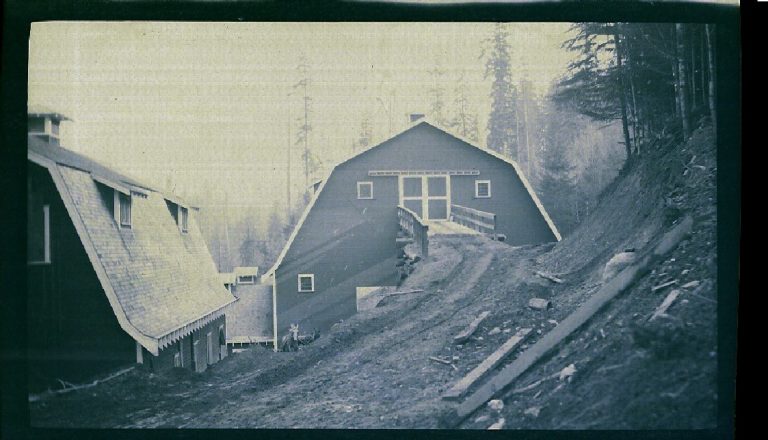
Damp hay that was accidentally included in one of the loads had spontaneously combusted and started the fire. As soon as they could get from the Mess Hall to the Main Barn, the prize-winning bulls were removed from the basement and the cows waiting for the next milking were ushered out safely. Others hooked up fire hoses, and with water pumped from Sikes Lake (the narrow lake that parallels Carnation Farm Rd), hosed down the barn and surrounding area to keep the flames from spreading. They continued fighting the fire throughout the night.
Although most of the Main Barn structure was destroyed by the fire, no animals or farm crew lives were lost. This was an amazing accomplishment at the time with no outside services in place to help tackle the fire. E.A. Stuart was so grateful that both human and animal lives were spared he recognized and commended his farm crew for their incredible acts of courage. He decided to rebuild the barn as quickly as possible and to make it larger than the original barn.
The farmhands rebuilt the barn with most of the materials harvested on-site. At 89,000 square feet, the new Main Barn became the largest barn in King County. The construction was completed in just under 3 months!
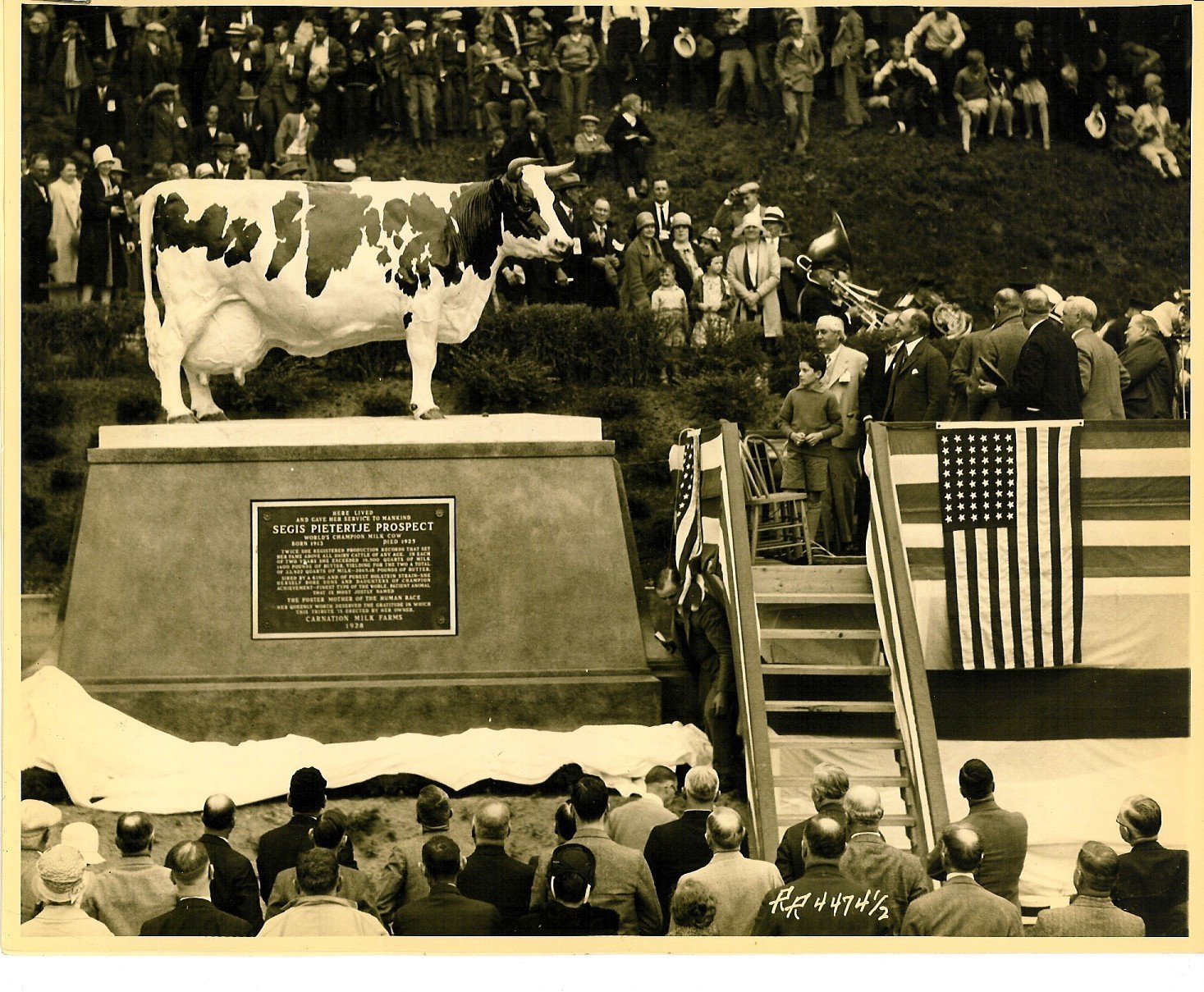
World Champion Cow Statue turns 90!
July 31, 2018
The cow statue that you find at our farm is of a most beloved cow named Segis Pietertje Prospect. Segis Pietertje Prospect, known lovingly as “Possum Sweetheart”, shocked the world with her incredible quantities of milk and helped Carnation Farms transform dairy production on a global scale.
When E.A. Stuart set out to improve production he did it with both science and love. E.A. was always interested in improving the quality of the Carnation bloodline through crossbreeding and line-breeding. He purchased the finest cattle and always hired experts to guarantee careful monitoring of the breeding, resulting in high production stock. He also ensured the cows were treated with care and respect. He instituted a policy that would ensure the cows were happy as well as healthy, with the idea that cows which avoided stress and mistreatment would be able to produce more milk. This is where the trademark idea, “home of contented cows,” was born.
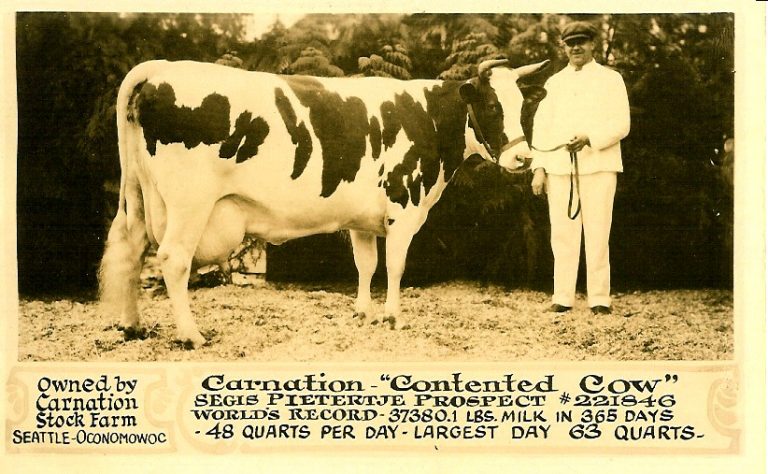
In the breezeway of the barn where many of the milking cows were housed, there remains to this day a sign which lays out guidelines for how to treat the cows:
“The RULE to be observed in this stable at all times, toward the cattle, young and old, is that of patience and kindness….
Remember that this is the home of mothers. Treat each cow as a mother should be treated. The giving of milk is a function of motherhood; rough treatment lessens the flow. That injures me as well as the cow. Always keep these ideas in mind in dealing with my cattle.”
E.A. also encouraged milk production by ensuring that each cow was paired with a compatible milker. This proved to be a winning strategy in 1921 with “Possum Sweetheart”, and a milker named Carl Gockerell. In 1900, the average yearly milk production for a cow was 1,500-1,900 pounds of milk per year. The combination of “Possum Sweetheart” and Gockrell resulted in a record-shattering 37,000 pounds of milk produced in one year. A record she was able to hold on to for nearly sixteen years!
Upon the passing of “Possum Sweetheart” in 1925, E A Stuart wanted to extend his heartfelt recognition of her amazing milk production by erecting a monument in her honor. The unveiling was done during the annual Washington State Holstein-Friesian Association picnic held at Carnation Farms on July 31, 1928. Everyone waited in anticipation when the monument was revealed of the beloved Segis Pietertje Prospect, world champion milk cow and most noted animal of this breed.
The unveiling event attracted over 3,000 visitors. In attendance were many dignitaries, government officials, dairy breeders, farmers, and family. Her fantastic record had drawn local, national, and worldwide attention for Carnation Farms and earned “Possum Sweetheart” her place in history.

Baseball at Carnation Farms
June 29, 2018
Every summer the Carnation Farm employees would look forward to the company picnic at the farm. The employees from both the Carnation Farm Headquarters, located in Seattle, and the Carnation location employees would have the opportunity to enjoy a picnic filled with fun, games, and lots of great food.
One of the much-anticipated highlights of the picnic was the annual baseball game. Each year this lighthearted rivalry was viewed as an opportunity for the “city” baseball team to compete against the “country” baseball team.
This photo shows a game from the 1920’s. The Carnation Farm “country” team is the victor with the final score of 3 to 2. Go Carnation!
Transportation Through Time
June 12, 2018
Did you know that Carnation Farms used to transport its milk by boat?
For the first several years the milk was taken by boat along the Snoqualmie River downstream to the Skykomish River. From there, the milk was unloaded and hauled by wagon four miles to the condensary.
When the railroad came in in 1911 we were able to switch to rail, but not without a bit of engineering. The rail line was located on the opposite side of the river, so a cable ferry boat (a boat the crossed the river by cables connected to both shores) was installed. The ferry boat would transport feed and cows from the farm to train. Eventually, the farm built a standard bridge across the river near the railroad to streamline the trip even further. You can still see supports from this bridge today.
Carnation King Sylvia
June 7, 2018
One hundred years ago today, June 7, 1918, E.A. Stuart shocked the world of dairy breeders when his bid for a bull calf far exceeded that of any previous purchase. Mr. Stuart’s bid of $106,000 (equal to $1.9 million today) for a bull calf silenced all competitors at the National Holstein Sale in Milwaukee, Wisconsin.
The auction had started off between half a dozen bidders, but when it hit $50,000 only two were left in the game, Mr. Stuart and the Morton Salt Company. From then they went back and forth by a $1,000 until they reached $101,000. Mr. Stuart was ready to end the bidding and jumped up to $106,000 at which point Morton Salt conceded.
Mr Stuart’s outrageous bid created instant fame for that bull calf and was reported in newspapers and magazines around the world. The calf was named Carnation King Sylvia.
Mr. Stuart took full advantage of the free publicity. He had a huge sign printed for the train boxcar King Sylvia was traveling cross country in. Mr. Stuart made frequent stops in towns along the way and at each stop the bull was paraded around for viewing by local dairymen, farmers, and townspeople. This was a chance in a lifetime to see this outstanding “Milking Bull” that helped put Carnation Farms on the map!

